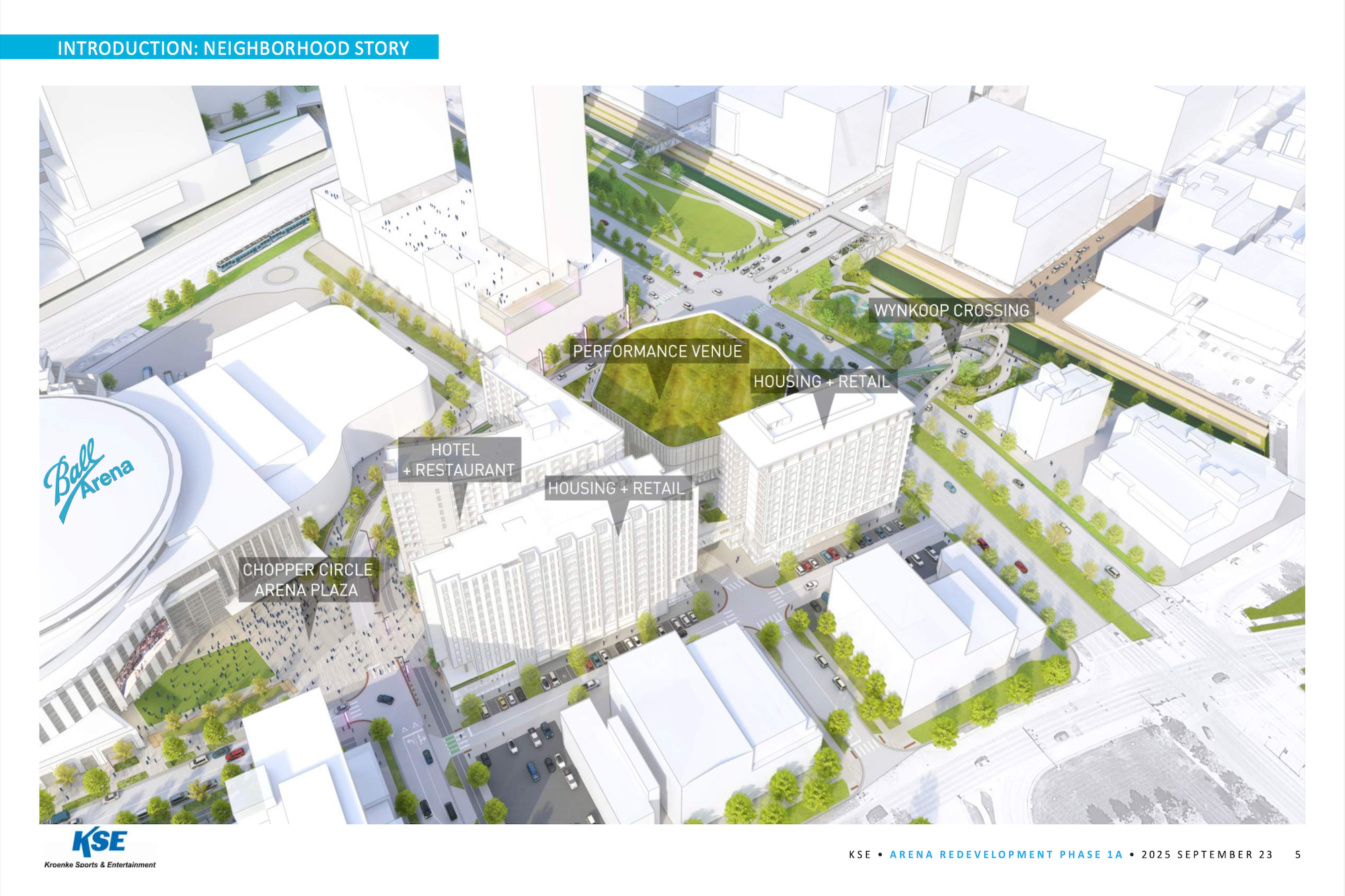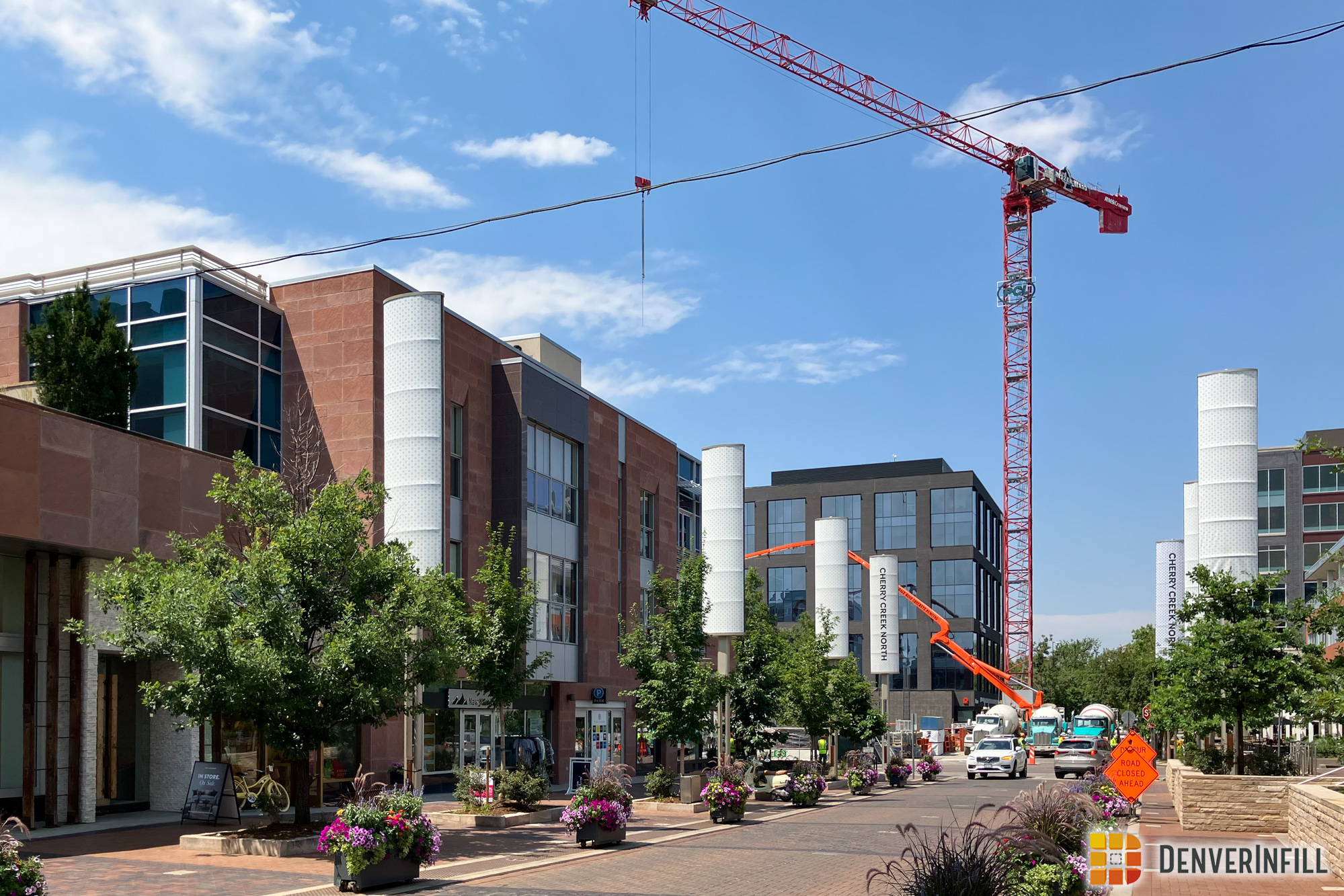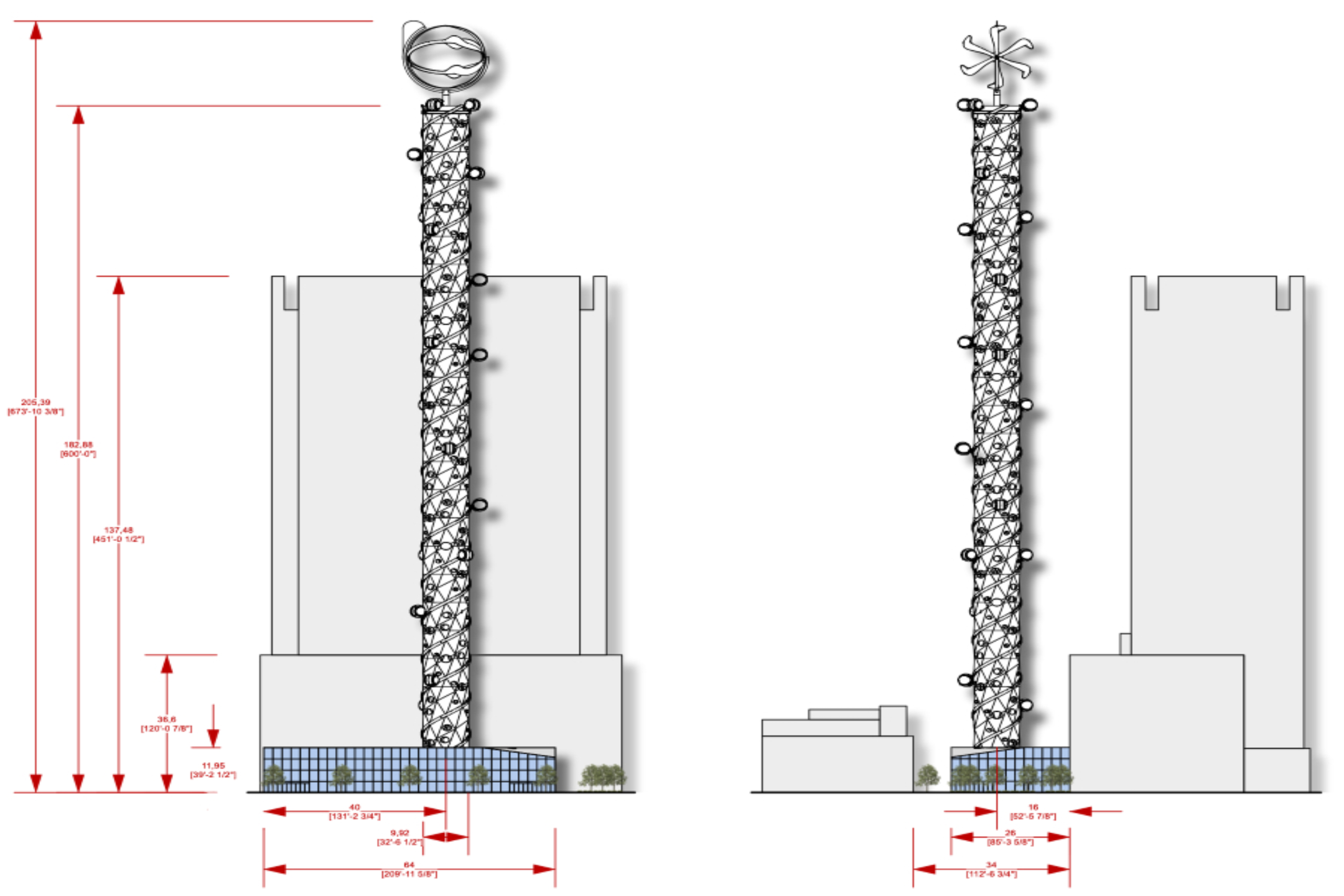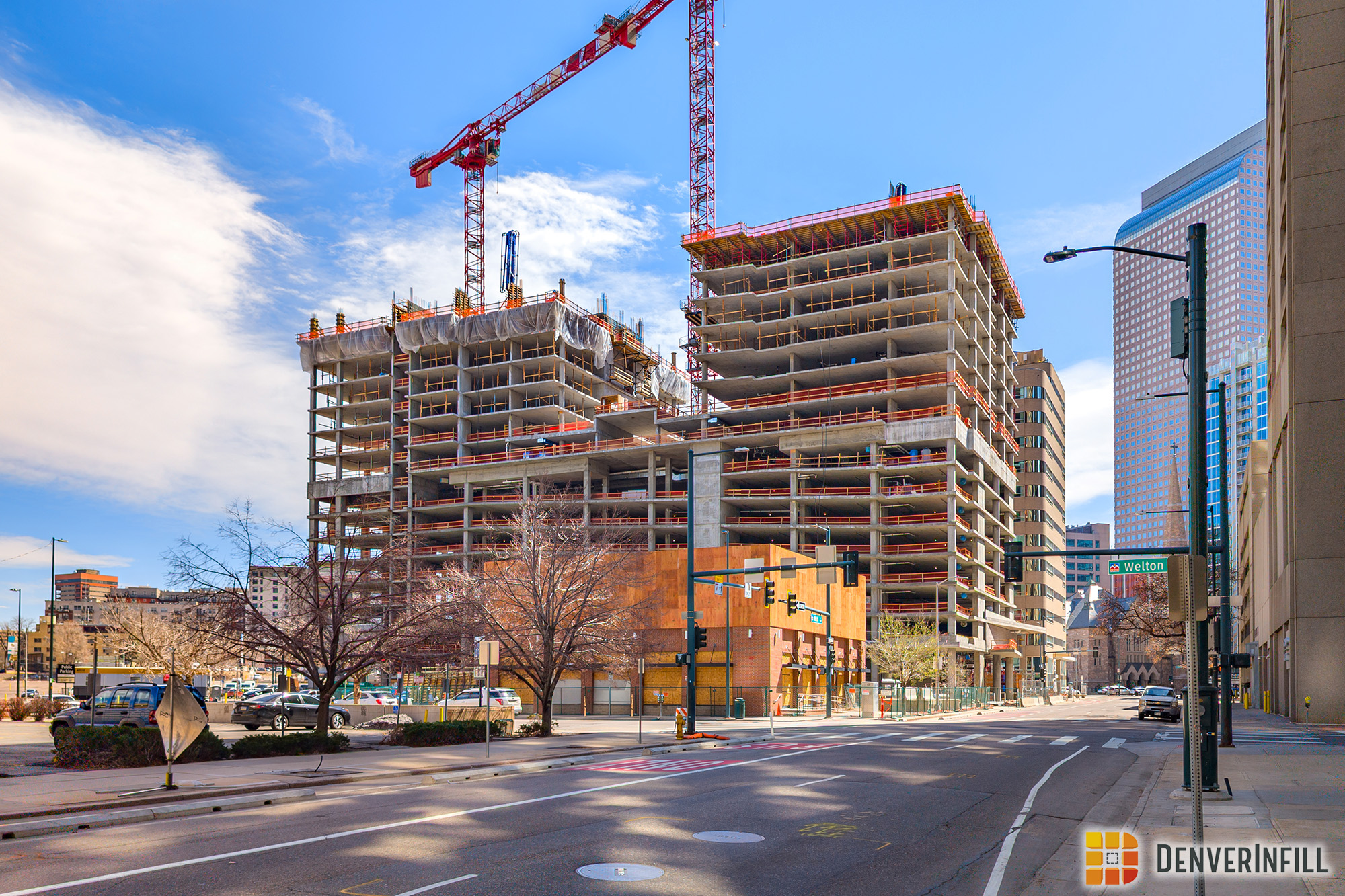I have updates on several fronts today.
Kiewit has started the process of laying tracks at the light rail station. Recently, hundreds of railroad ties were delivered over the past few days and are staged on site. This morning, rails have been moved from the staging area. Using a specialized machine, the ties will be set six at a time. I’ll show off my new vocabulary: Once the ties are in place, crews will begin “stringing the track” and will use “E-clips” to fasten the tracks to the ties. After the tracks are strung, a “tamper” will shake the track and ties to hasten their settlement into the “ballast” (big rocks) which has been spread over the top of the “sub-ballast” (small rocks). Keep tuned in to DenverInfill for the first photos of the new tracks. In the meantime, here’s a shot of the staged ties and the groomed ballast.
As Chachafish pointed out in their comment on Update #45, the fabric was installed late last week over the light rail canopy frame. It looks pretty sharp. Here is a photo of the finished product.
If you have spent some time lurking under the Millennium Bridge, you probably noticed that a transformer blocks the right of way between the current light rail tracks and the new station. That transformer, which powers the light rail, will be moved three months prior to the cutover to the new light rail station so the tracks can continue on their way under the bridge.
Tracks at the temporary Amtrak station will be laid in January shortly before the station becomes operational on February 1. The certificate of occupancy for the station was issued on Monday.
As you can see in the photo below, construction of the bus terminal roof has resumed. More beams are being installed and preparation is also underway to pour concrete over the first portion of the roof. Pouring concrete on a roof is especially tricky this time of year. Workers will probably have to heat it from below so it dries properly. As Bostonians know from a Big Dig failure, it’s not a good idea to have faulty concrete on a roof.
The dewatering system is being downsized now that the bus terminal floor is completed, the walls are nearly done, and the water table is seasonally low. Before digging starts on the second half of the terminal, new wells will be drilled along its eventual perimeter between Wewatta Street and Union Station, and the dewatering system will be reinstalled to keep the new digging location dry. You can see before and after photos of the dewatering system at Jobsite Visitor.com. Go to the “Plan View” tab, find the appropriate camera angle, and click through various weeks to see changes. By the way, you can use that section of the website to see weekly changes of the project from the nine camera locations that are shown along the freight tracks.
A few days ago, backfilling along the 18th Street side of the bus terminal began. Here’s a photo of the progress.
We should start saying our good-byes to the Union Station tunnel. It will be gone in late-winter or early spring. To me, the loss of the tunnel is the only real downside of this fabulous project. I use it as an oasis from the cold in the winter and from the sun in the summer. I soak up its history several times a week. My dad walked through that tunnel during an overnight stop in Denver in 1946 on his way home from the Pacific Theater to Western New York after his 4-year stint in the Marine Corps. For six decades, I listened to his fond stories of his short stay in Denver. There wasn’t much to say, but it was important enough for him to say it many times. He died last year at 92. Thousands of others made the walk through that tunnel. For many, it was one-way.
I have posted 13 new photos, including the ones in this blog, on our Denver Union Station page at JobSiteVistor.com.















I’ve really enjoyed all the updates you’ve posted on this project. Back in the 1980’s, I was able to tour the depot during a model railroad convention in Denver, and it was pretty amazing to see behind the scenes – the attic above the main waiting rooms, the offices, basement, and other spaces in the terminal. It is nice to know this impressive building is still going to be around and in use, and hasn’t fallen into disrepair like so many major city terminals.
One question I would like to ask about the Union Station tunnel. Are you thinking of the old tunnel that ran from the station under the tracks to provide platform access? If so, are there any plans to save some parts of the tunnel, like the platform signs or other things? I seem to recall each platform had a large metal structure that held track number info, and a place for train names and the like. And will the new tunnel enter the terminal through the same opening in the building?
Mike, yes I am referring to the tunnel you described. There is intense interest in saving as much of the tunnel as possible so I am as sure as I can be (knowing I have zero control or influence) that stuff will be saved.
Sweet photo of the light rail canopy frame. Along with the 18th Street pedestrian bridge, the viaduct and the Skye Urban Apartments in the background, it really captures the energy of the area.
I have been taking weekly photos from the pool deck of the GH since the floor went in…..it is amazing how quickly they are going to have finished the bus terminal and covering it up. Obviously, there will be lots of interior work to do, but the size of this project is impressive. One question that I did have (not sure if there is an answer out there yet)….how/are they going to open the light rail on the new tracks without the underground bus barn being completed? What I mean is, it would be quite an inconveience to walk from the new LR station to the 16th street mall buses with all of the other construction still going on.
Chris, the new light rail station and the new mall bus station will open at the same time, and they are adjacent to one another. The mall bus will not use the underground facility. Mall buses will drive further down 16th Street to the eventually rebuilt Chestnut Place, turn right onto Chestnut, turn left onto a new section of 17th Street, then turn left and park at the new station. You can see the mall bus canopy in the first photo in Update #45. It’s the short, fat one.
By the way, you and I are Glass House neighbors. Many of my photos are from the pool deck. It’s great vantage point.
Rick-
Any idea when the mall bus/light rail will open on this side? I have been taking most of my photos on Sat or Sunday mornings since it’s dark when I leave and dark when I get home!
Chris
Chris, I don’t know. I fact, I’m not sure anyone knows for sure. A good guess would be summer 2011.
Good news. The days will start getting longer on Wednesday.
is this the first we are publicly hearing about losing that FANTASTIC tunnel? I know the answer we will hear from E/W regarding costs, function etc….but its a small, wonderful piece of denver history that sure would be great to keep.
mrs. crawford and peter park…where are you?
The tunnel has been planned to be taken away for years. It is literally obstructing the rest of the bus tunnel it would dead-end right into the wall of the bus tunnel.
Maybe people should have paid a bit of attention over the last 4 or so years to know how Union Station was going to be altered.
The tunnel’s elimination has been planned for years, as PJA said.
Count me among those who didn’t realize the tunnel’s days are numbered. I always try to detour through the tunnel whenever I’m on the other side of Union Station and every time I do I’m reminded of the thousands of people who once made the same short journey. There’s a lot of history in that part of the station. Hopefully, RTD might be able to use some of the pictures, the old menus and some of the other memorabilia to decorate the new Union Station.
First I’ve heard about the tunnel, too. I know there have been several changes to the Union Station plans over the past few years, so it’s hard to keep up, but I somehow didn’t realize we were going to lose this magnificent little piece of Denver history. I also find myself thinking about all the riders of times past that have moved through Denver via rail when I walk down the tunnel to get from Union Station to the light rail.
I was rather hoping some of the tunnel could be restored for light/commuter rail platforms, but I guess it’s not to be. What a loss and what a shame. If there’s any way to save as much of it as possible, please let us know.